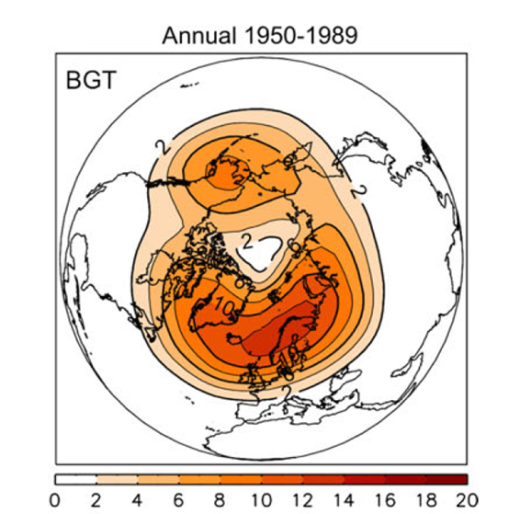Research
- Climate Variability
- Weather types
- North Atlantic Oscilation
- Blocking events
- Storm-tracks
- Cut-off low systems
- Climate extremes
- Vegetation dynamics
- Atmopsheric Rivers
- Nonlinear Analysis
- Natural Hazards
- Datasets
Blocking events
Atmospheric blockings are quasi-stationary persistent high-pressure systems that play a decisive role in mid-latitude climate. Blocking detection methods can be categorized in two main approaches based on absolute meteorological fields or departures from a climatological mean. The most commonly used methods are the ones of Tibaldi and Molteni (1990) and Dole and Gordon (1983), but the blocking climatologies derived from these different methodologies indices can exhibit large differences and some authors have attempted to reconcile both approaches (Barriopedro et al., 2006). Fig.1 portrays the mean distribution of blocking locations in the Northern Hemisphere as obtained by Barriopedro et al, (2010). Blocks play a decisive role in mid-latitude climate as their occurrence is intimately related with intense climate anomalies over various sectors of Europe (Fig. 2). Generally speaking Blocking episodes are associated with extremely cold weather in winter and very hot days in summer.
The processes behind blocking onset, maintenance and decay are still under great debate, and there have been significant advances on the comprehension of the intimate relation blocking episodes with the troposphere-stratosphere coupling (Woolings et al 2010), but also from snow cover anomalies (Cohen and Jones, 2011). However the mechanisms behind other types of blocking events are yet to be entirely understood.
The climatology and climate change group has been developing work on the characterization of blocking episodes and use of different indices (e.g. Trigo et al., 2004; Barriopedro et al., 2010a, 2010b) as well as on the climatic impact imposed on surface variables that depend considerably on the season. Major summer heatwaves in Europe, such as during 2003 in western Europe (Trigo et al., 2005) or 2010 in Russia (Barriopedro et al., 2011) and cold winter spells (Trigo et al., 2004) have been closely related with blocking occurrence (Fig. 2). Furthermore, the occurrence of several blocking events during winter and spring provoke precipitation scarceness and eventual drought episodes causing economic losses, such as the 2004/05 century-record drought that affected Iberia (Garcia-Herrrera et al., 2007). Under certain circumstances, blocking episodes may favor local events of intense precipitation, as storm tracks tend to be deflected north and south of blocking systems. In particular, blocking conditions can be favorable for strangling cold air pools (cut-off lows) which may produce severe weather and flooding (Nieto et al., 2007). Blocking events are also intimately associated with extreme cold (warm) episodes in winter (summer).

Figure 1. 2-D blocking distribution. Climatological annual mean blocking frequency (in percentage of annual days) as derived from the index proposed by Barriopedro et al. (2010).

Figure 2. The mean 500 hPa geopotential height (gpm) anomalies for all winter (a) blocking, and, (b) non-blocking episodes, with a minimum duration of 10 days. The shading shows the corresponding 850 hPa temperature field (ºC); c) Differences between the mean 500 hPa geopotential height (gpm) composites and the corresponding 850 hPa (ºC) temperature composites (represented only if significant at the 1% level). (From Trigo et al., 2004)
References:
- Barriopedro D, García-Herrera R, Lupo AR, Hernández E, 2006: A climatology of Northern Hemisphere blocking. J. Climate, 19, 1042–1063.
- Barriopedro D., García-Herrera R., Trigo R.M. (2010a): Application of blocking diagnosis methods to General Circulation Models. Part I: A novel detection scheme. Climate Dynamics, 35, 1373-1391, doi: 10.1007/s00382-010-0767-5.
- Barriopedro D., García-Herrera R., González-Rouco J.F., Trigo R.M. (2010b) "Application of blocking diagnosis methods to General Circulation Models. Part II: model simulations". Climate Dynamics, 35, 1373-1391, DOI 10.1007/s00382-010-0767-5
- Barriopedro D, Fischer EM, Luterbacher J, Trigo RM, García-Herrera R, 2011: The Hot Summer of 2010: Redrawing the Temperature Record Map of Europe. Science 332, 220, DOI: 10.1126/science.1201224.
- Cohen J, Jones J, 2011: A new index for more accurate winter predictions. Geophysical Research Letters 38, L21701, doi:10.1029/2011GL049626.
- Dole RM, Gordon ND, 1983: Persistent anomalies of the extratropical northern hemisphere wintertime circulation: geographical distribution and regional persistence characteristics. Mon Weather Rev 111:1567–1586.
- Garcia-Herrera R., Paredes D., Trigo R.M., Trigo I.F., Hernández H., Barriopedro D., Mendes M.T.: The outstanding 2004–2005 drought in the Iberian Peninsula: associated atmospheric circulation, J. Hydrometeorol., 8, 483–498, 2007.
- Nieto R., Gimeno L., de la Torre L., Ribera P., Barriopedro D., García-Herrera R.: Interannual variability of cut-off low systems over the European sector: the role of blocking and the northern hemisphere circulation modes. Meteorology and Atmospheric Physics 96, 85-101, 2007.
- Tibaldi S., Molteni F.: On the operational predictability of blocking. Tellus, 42A, 343-365, 1990.
- Trigo R.M., Trigo I.M., DaCamara C.C., Osborn T.J. (2004) "Climate impact of the European winter blocking episodes from the NCEP/NCAR Reanalyses". Climate Dynamics, 23 (1): 17-28.
- Trigo RM, García-Herrera R, Díaz J, Franco Trigo I, Valente MA, 2005: How exceptional was the early August 2003 heatwave in France? Geophys Res Lett 32:L10701 doi: 10.1029/2005GL022410.
- Woollings T, Charlton-Perez A, Ineson S, Marshall AG, Masato G, 2010: Associations between stratospheric variability and tropospheric blocking. J. Geophys. Res., 115, D06108, doi:10.1029/2009JD012742.